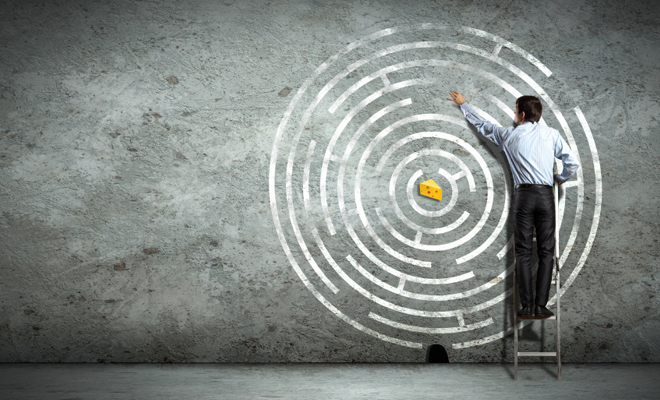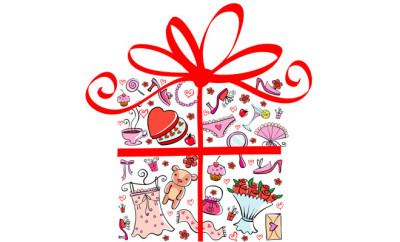
Problem Solving Strategies
We’re used to living in an either-or world—but when it comes to yes-or-no dilemmas, says Martha Beck, the most powerful thing you can ask is: What if both answers are true?
“At first I thought Jack was just a rebound dater wanting to make a conquest,” said Fiona over dinner with her girlfriends. “But he’s called every day since our first date, and he’s really sweet. He remembers my favorite song, he reads my blog—I think we really connected.”
“Sounds like a dream come true,” said Judith.
“On the other hand,” Fiona countered, “he talks about his ex-girlfriend a lot, and he started hinting about sex five minutes after we met.”
“Bad sign,” Kathleen said. “Don’t let the whole ‘favorite song’ thing fool you. He’s just a player. He’s thinking, ‘Oh, yeah, I’m all that.'”
“What if both things are true?” This came from Deborah, who’d been listening silently in the corner. “Maybe he’s a man-slut with a bruised ego trying to get someone in the sack, and he’s a thoughtful person who really likes you.”
The pregnant pause that followed could have given birth to triplets. When the conversation resumed, it was suddenly…deep. If the guy in question could be a combination of seemingly opposite traits, might not the same be true in other instances? Could Judith’s recent job loss also be a stroke of great luck? Was Kathleen’s workaholism both vaunting ambition and a humble desire to serve? And what about all those politicians and athletes—could they truly have the ideals of angels in their hearts and the morals of goats in their pants?
Uh…yes. Think of dilemmas like these as dual-emmas. Unlike standard-issue questions, dualistic dilemmas confuse people by leading to two apparently true but contradictory conclusions. Maybe you’ve found this in your own life: Perhaps your marriage is both wonderful and terrible, your job both wretched and stimulating, your worst habit both destructive and helpful. Reconciling these apparent brain-benders seems impossible, but if you understand the dynamics of dualism, you can transform bewildering dilemmas into sources of insight.
“On the Horns of a Dual-emma
There are two kinds of people in the world: those who divide everyone into two kinds of people, and those who don’t. The tendency to dichotomize is stubbornly pervasive in human thought. Maybe this is because it presents decision-making in its simplest form. In evolutionary terms, this method has obvious advantages. Commit to one choice and you’re done. If you’re an early human on the savanna, you’re better off fearing all snakes than having to closely examine each specimen for venom glands.
Even in our more nuanced world, this approach still works. You don’t need the company of a snake to thrive, so you can avoid them all. But things become complicated when you get what a nurse friend of mine calls a mixed IV drip of essential fluids and poison—when a person or situation seems to provide necessary things like love and comfort but is also the source of pain and upset.
Confronted with such dualities, most of us try to choose between them. Friends and advisers weigh in on each option—and both camps make sense. Your instinct is to hunker down and figure out which is the “right” answer. After all, how else will you decide to stay or divorce, quit or stick with it? But limiting ourselves to one answer means we often stop seeing what’s actually happening, and we make decisions based on labels instead: “The guy is a player, so no date,” or “This friendship is dysfunctional—begone!” This strategy feels right…until the guy or the friend does something truly sweet, gives you the kindness and affection you love and need, and there you are, spiked again on the opposing horns of the dual-emma.
The problem is that an either-or thought process won’t resolve a both-and reality. This point was once driven home for me by a client I’ll call Janet, who brought her teenage daughter “Angela” to a coaching session. Angela tearfully confessed, “I’ve been doing drugs and having sex with boys.” Janet calmly replied, “No, you haven’t; you’re a good girl.”
Then she turned to me and asked, “What’s the real issue here?” The real issue was that Janet had no way to deal with the possibility that Angela was a good girl who also did drugs and had sex. In Janet’s mind, a good person, like her honor-roll daughter, has no bad characteristics. Unable to bridge the divide, Janet went mind-blind to Angela.
Like Janet, we make judgments about all kinds of people, deciding, for instance, that surely the legendary athlete with his boyish smile and beautiful family would never succumb to roid rage. Or that the mousy homemaker next door would never have a torrid e-mail affair. We’re not only shocked when those assumptions don’t hold up, we’re unsure how to handle the new information.
The only option for Janet, for you, for anyone who’s confronted with two apparently opposite sets of data, is to blast apart the mental dichotomies that organize our minds and drive our behavior. How do you respond to the harassing boss who gives you wonderful, career-building feedback but throws degrading tantrums? Or the friend whose loyalty never fails, except that she flakes and forgets to pick you up after your appendectomy? Are they good people you want in your life or jerks you should avoid?
Yes.
If you scrutinize your own life, you’ll find you do plenty of things that violate the dichotomies in your mind. I certainly do. We’re considerate, selfless, and clever (except for the times we aren’t). Or we’re luckless losers (not counting the infinite things that go right for us every day). This is the problem with either-or thinking: It keeps us removed from reality, and it requires that we spend a lot of time and energy convincing ourselves that life is one particular way (and burying evidence that doesn’t jibe with that view). More important, it will never feel truthful or satisfying—because it leads to an answer that’s only half-right.
What to Do When Both Things Are True
In mathematics, one kind of problem that sends the mind bouncing back and forth between seemingly opposite truths is called a strange loop. The only possible way out is for mathematicians to use a metastatement that draws attention to the loop itself. In the case of a dualistic dilemma, the metastatement is “Oh, I’m using either-or thinking when both-and thinking is required.”
What makes a both-and mind-set so powerful is that it takes you beyond the two choices you thought you had. It opens up new, previously unseen possibilities and opportunities.
There is one caveat to all dual-emma relationships: If you or the other person involved can’t or won’t admit the whole truth—”Yup, I have a Dr. Jekyll side, but there’s also a Mr. Hyde in here”—the relationship will become increasingly dysfunctional.
If both parties can discuss the full range of their behavior, however, almost any relationship can work. You just need to follow three basic steps:
1. Set Boundaries That Correspond to The Worst of Times
According to Abraham Maslow’s famous hierarchy of needs, the very first psychological need we have is to know we’re safe. That’s why, when you’re around someone who’s both good and bad, your first step is one that may seem a bit cruel: When times are good, establish limits that prepare you to deal with the relationship when times are bad. This is how you’ll keep from being blindsided by something that—hello—you’ve already learned.
If your boss is a sweetheart who has tantrums, agree with him during a reasonable moment that you’ll both observe certain rules of engagement: “No shouting, or we go to our offices and cool down until everyone’s feeling civil.” If your supportive friend tends to space out, ask someone more dependable to do a crucial favor. If your loving mom has bouts of negligence, don’t entrust her with your twin toddlers.
2. Focus Your Appreciation on the Best of Times
In his book What Happy People Know, psychologist Dan Baker, PhD, describes an elderly woman named Marlene reminiscing about her beloved late husband. When Baker said he must have been a good man, Marlene said, “He was a womanizer and a drunk. A real pain in the butt.” She simply chose to focus on the deep and abundant love they’d shared. Baker considered this choice a key to her health and happiness.
Notice there was no denial in Marlene’s image of her husband; she acknowledged all his faults and refused to gauze over his memory. And then she chose to bask in his best legacy rather than his terrible betrayals. Setting strong boundaries frees us to take this attitude—and it allows us to access the happiness that’s available right now.
3. Remain Calm While You Explore Your Options
That phrase—”right now”— is important. When you’re dealing with a dual-emma, focus on being fully present with what’s happening in this moment, rather than assuming past bad (or good) behavior predicts future consistency. This means alternating freely between the two previous steps. You don’t want to spend your life anticipating your boss’s next meltdown; neither do you want to assume that his jovial, charming behavior will last through the week. As you explore the scope of the other person’s actions, you’ll learn whether you can accept this particular mixed IV drip.
In Fiona’s case, this meant realizing that, yes, Jack may be a player—and a really compatible match. Maybe, as Kathleen said, “he thinks he’s all that” at some times but is grounded, affectionate, and responsive enough at others to make his occasional narcissism worth tolerating (with appropriate boundaries—”I’m going to watch TV while you preen, Jack dear. Call me when you’re finished!”).
As they contemplated Deborah’s idea that a scoundrel could also be sincere, Fiona and her friends began, in the words of one yogi, “existing in continuous creative response to whatever was present”—in their love lives, their careers, their definition of self.
Try seeing your world and yourself this way, eyes open to whatever is before you, mind free of dichotomies. Are you good or bad, fragile or tough, wise or foolish? Yes. And so am I. What Jack thought about himself (at least according to Kathleen) is true of every human being. Oh, yeah. We’re all that.
First published at Oprah.com.







